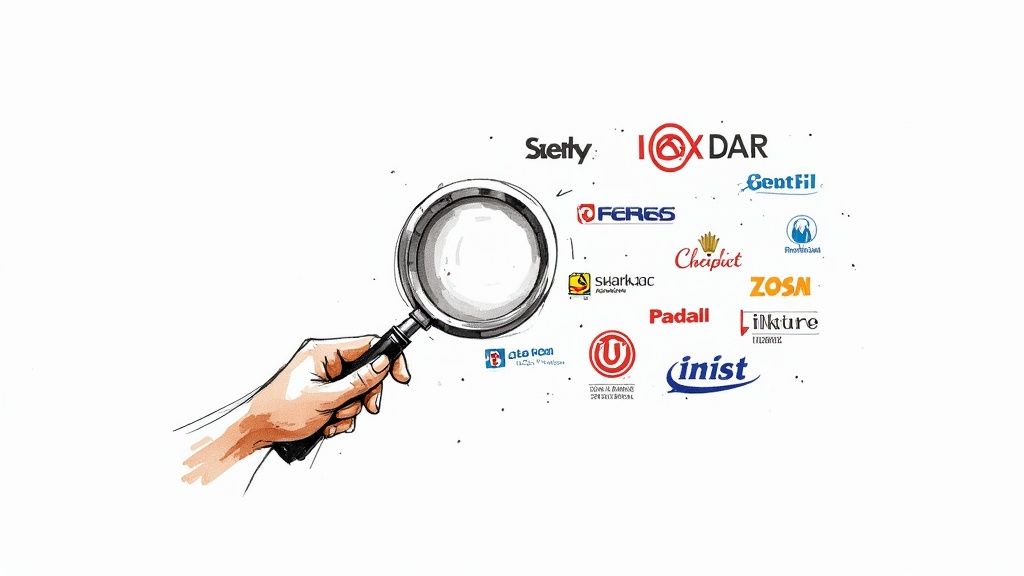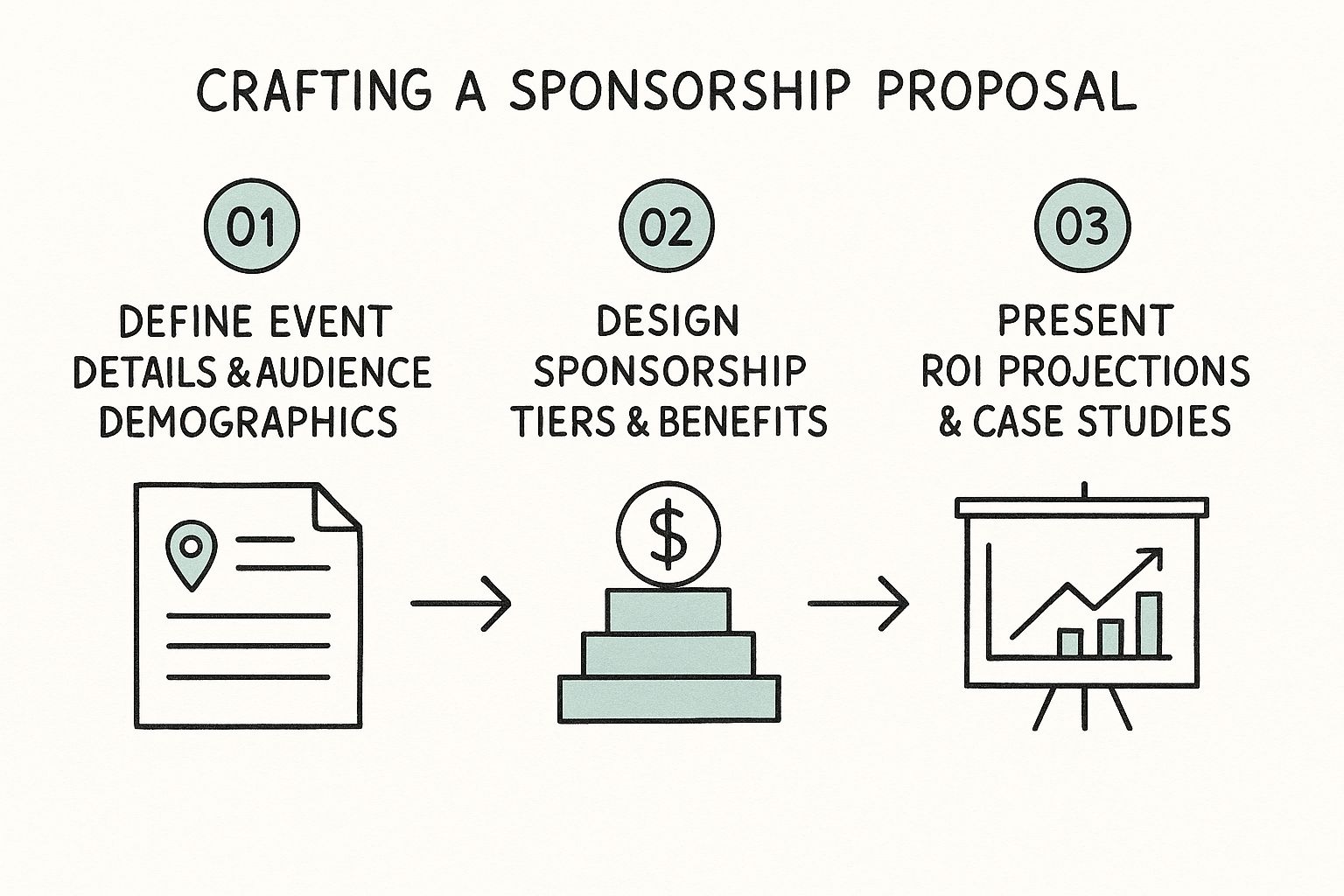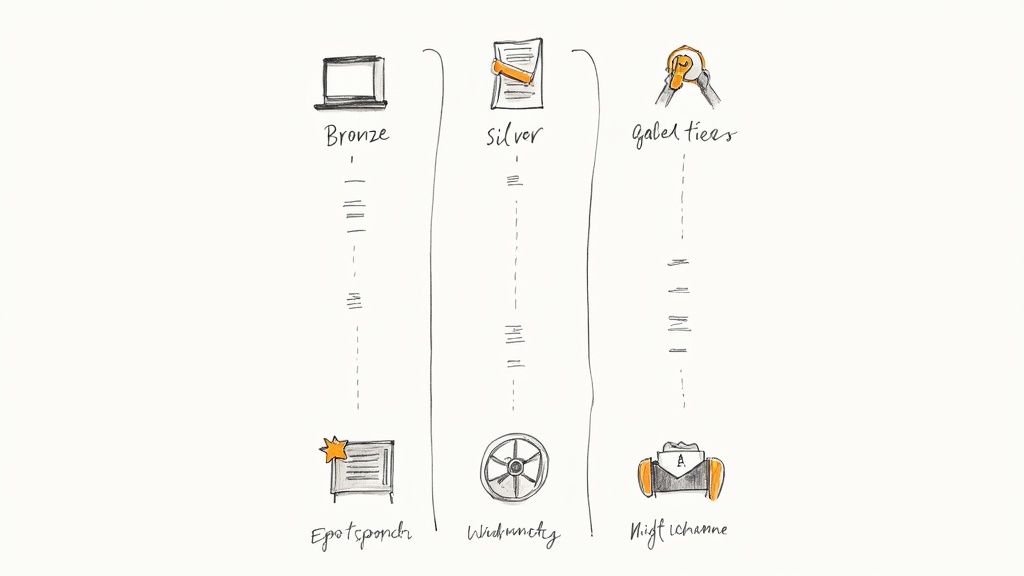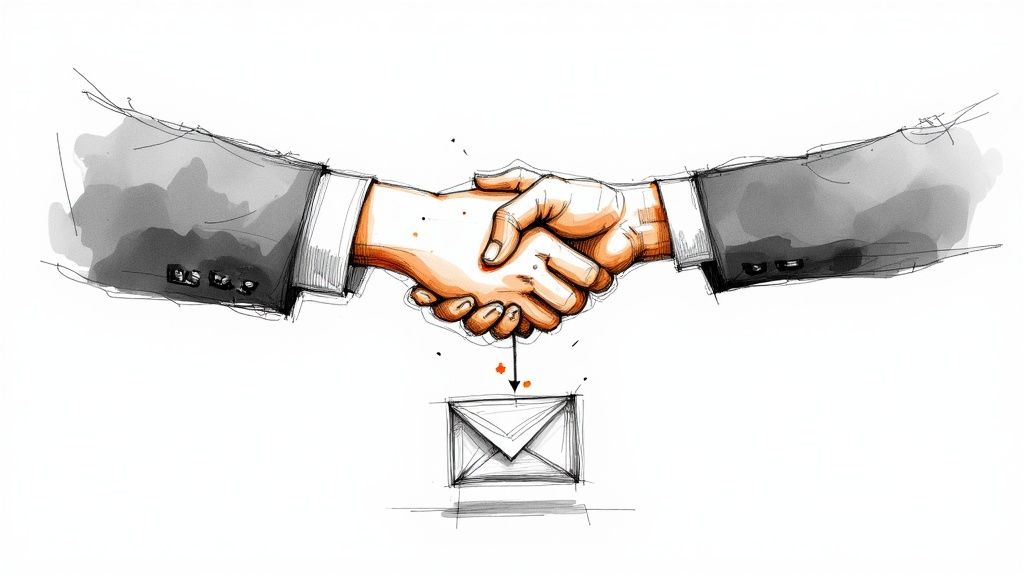October 2, 2025

Securing a great sponsor for your event is all about showing them you can connect them with the right people. It boils down to a simple exchange of value: you offer access to their ideal customer, and they provide the resources to make your event unforgettable. The whole game is about pinpointing brands that align with your audience and then crafting a compelling story that makes partnering with you a no-brainer marketing decision.
Before you even think about writing that first email, the real work begins. You have to lay the groundwork. Chasing sponsors isn't about panhandling; it's about selling a valuable, targeted marketing channel. To pull this off, you need to know exactly what you're offering and what you're asking for. Without that clarity, you'll just sound like everyone else, and your proposals will fall flat.
Think of this phase as your strategy session. You need to step into a potential sponsor's shoes for a minute. They aren't cutting you a check out of the goodness of their hearts—they're investing in results. Your job is to make those potential results feel real, believable, and, frankly, exciting.
Every event has a secret sauce. What’s yours? Maybe you offer a direct line to a notoriously hard-to-reach audience, like fintech CEOs or Gen Z creators. Or maybe your strength is massive brand exposure at a huge consumer festival. Whatever it is, this unique value proposition (UVP) is the heart and soul of your pitch.
To nail it down, ask yourself a few tough questions:
Key Takeaway: A powerful value proposition is never about what you need. It’s always about what a sponsor gains. You have to position your event as the perfect solution to their marketing headaches, whether that's generating leads, boosting brand awareness, or building community trust.
Once you've defined what you're selling, you need to figure out what you're asking for. A vague request gets you a vague "maybe," which is just a slow "no." Your sponsorship goals need to be specific, measurable, and tied directly to what it takes to run your event. This clarity makes it easier to build sponsorship packages and ensures you’re talking to the right partners about the right things. A huge piece of this is having your numbers in order, which you can dive into with our guide to budgeting an event.
Start by breaking down your needs into a few buckets:
When you clearly define what you offer and what you need, you stop sounding like you're asking for a handout. You start sounding like a strategic partner ready to deliver a solid return on investment. That foundation is what gives you the confidence to walk into any conversation as an equal, not a supplicant.

The secret to landing great sponsors isn't about how many companies you contact; it’s about who you contact. Blasting a generic proposal to a hundred companies is a fast track to a hundred rejections. You'll find real success in smart matchmaking—finding brands whose customers and values are a perfect match for your event.
Forget the scattergun approach. Your real job is to build a highly targeted list of prospects who are a natural fit. It takes some detective work, but the payoff is huge. A thoughtful, personalized pitch to the right ten companies will always beat a generic email blast to a hundred.
When most people brainstorm sponsors, they immediately jump to the biggest names in their industry. While it’s great to aim high, this often means you're overlooking a goldmine of partners who are more accessible and, honestly, a much better fit.
To build a solid prospect list, you need to think a little differently. I’ve had the most success by looking in these often-ignored places:
Building this list means you have to get your hands dirty. Tools like LinkedIn Sales Navigator are fantastic for filtering companies by industry, size, and location. I also spend a lot of time browsing trade publications and lurking in relevant online communities to see who the active players are. Exploring different business networking groups can also put you in the same room—virtual or otherwise—with potential partners already invested in your world.
Once you have a list of potential sponsors, the real work begins. This is what separates the amateurs from the pros. Your mission is to understand each company's marketing goals, their recent campaigns, and what they stand for as a brand. This is how you make your pitch feel like it was written just for them.
Don't just skim their homepage. You need to dig deeper to find the intel that makes your outreach impossible to ignore.
The sponsorship world is changing. Brands are tired of just slapping their logo on a banner; they want real, authentic connections. They are focusing on fewer, more meaningful partnerships that align with their commitments to values like DEIB (Diversity, Equity, Inclusion, and Belonging) and ESG (Environmental, Social, and Governance). You need to frame your event as a strategic opportunity that helps them achieve these bigger goals.
Pro Tip: Set up Google Alerts for your top 5-10 prospects. You’ll get an email when they launch a new product, get a press mention, or hire a new CMO. This gives you the perfect, timely reason to reach out with a pitch that feels incredibly relevant.
This groundwork is your secret weapon. When you finally make contact, you won't be a stranger asking for a handout. You'll be a well-informed peer presenting a custom solution to their marketing challenges, which dramatically increases your odds of getting that "yes."
Alright, you’ve done the hard work of identifying your dream sponsors. Now comes the moment of truth: crafting a sponsorship proposal that actually gets read and, more importantly, gets a "yes."
Think of your proposal as your single most critical sales tool. It’s not just a menu of prices; it’s the story of why this partnership makes perfect business sense for them. A generic, slapped-together document is a one-way ticket to the trash folder. A truly compelling proposal, on the other hand, connects your event’s energy directly to a sponsor's marketing goals.
This is your chance to frame this as a strategic marketing investment, not a charitable donation. It needs to be sharp, persuasive, and packed with data that proves you understand their brand and can deliver real results.
Every proposal that I've seen succeed follows a clear, logical path. It guides the reader from understanding the opportunity to seeing the undeniable value for their brand. You're building a case, piece by piece. If you're starting from scratch, looking at some effective sales proposal templates can give you a solid framework to build upon.
No matter the event, your proposal needs these core sections:
This visual breaks down the workflow for putting together a proposal that works, starting with the foundational details and building up to the specific value you deliver.

As you can see, a successful proposal isn’t just thrown together. It’s built on a logical progression: start with your audience data, design packages that make sense, and wrap it all up with a strong case for ROI.
Creating your sponsorship packages is more art than science. The goal is to give sponsors clear choices that naturally guide them to the right investment level, all while showing value at every price point. A common mistake is making the tiers too similar, which just confuses people and leads to them not making a decision at all.
For a great real-world example, check out our guide with a complete https://groupos.com/blog/sample-sponsorship-proposal that really breaks down how to structure these tiers for maximum impact.
My biggest piece of advice: The most powerful benefit you can offer is exclusivity. Create a "Presenting Sponsor" or "Title Sponsor" package at your highest tier that guarantees they are the only brand from their industry at the event. That single promise can be worth more than a dozen smaller perks combined.
And please, think beyond just slapping a logo on a banner. Today’s sponsors crave meaningful engagement. Here are a few ideas to pack into your higher-value packages:
The following table provides a clear example of how to structure your tiers, ensuring each level offers a distinct and escalating set of benefits. This tiered approach helps potential sponsors easily identify the package that best aligns with their budget and marketing objectives.
By visualizing the packages this way, you make the decision-making process straightforward for sponsors, highlighting the clear value proposition of moving up to a higher tier.
The game has changed. The global sports sponsorship market alone was valued at USD 60.17 billion in 2024 and is projected to skyrocket to USD 132.86 billion by 2033. A huge part of that explosion is the shift to virtual and hybrid events.
Brands are quickly learning that digital sponsorships offer clearer metrics and more personalized ways to connect with an audience. Instead of just paying for physical signs, they can now invest in immersive online experiences that deliver immediate, measurable results.
By presenting a well-researched, beautifully designed proposal that tells a compelling story, you shift the conversation. Your event is no longer just another expense—it’s an unmissable opportunity for a sponsor’s growth.

You've built a rock-solid proposal and a killer prospect list. Now for the hard part—and the most human part: reaching out and starting a real conversation. This is exactly where I see so many event organizers stumble, sending generic emails into the void and wondering why they never hear back.
Let's be clear: a great proposal is totally useless if it never lands in the right inbox. Your goal isn't to just blast your pitch out. It’s to connect with a person, build some genuine rapport, and navigate the delicate dance of negotiation. Success here is all about a thoughtful strategy, not just a numbers game.
Your first instinct might be to email the CEO or fire off a message to a generic "info@" address. Trust me, in almost every case, this is a mistake. The real key to getting your proposal seen is finding the specific individual whose job it is to evaluate opportunities just like yours.
Think about who actually controls the budget and strategy for the kind of partnership you're offering. It's almost never a single person.
LinkedIn is your best friend here. Get comfortable with its search filters to narrow down employees by title and department at your target companies. When you find a promising contact, resist the urge to send a blind connection request. Instead, see if you have any mutual connections who could make a warm introduction—this simple step can genuinely increase your response rate tenfold.
My Two Cents: Don't be afraid to start a conversation with someone who might not be the final decision-maker. Getting a Brand Manager to forward your proposal to their Director is a huge win. Your first goal is to find an internal champion for your event.
Decision-makers are absolutely bombarded with hundreds of emails a day. A generic, copy-pasted message is destined for the trash folder. Your outreach needs to be personal, concise, and focused entirely on them.
The subject line is your first—and sometimes only—chance to make an impression. Ditch the vague titles like "Sponsorship Opportunity." Get specific and make it compelling.
Weak Subject Line: "Sponsorship Inquiry"
Strong Subject Line: "Partnership Idea for [Company Name] & [Your Event Name]"
Keep your email short and scannable. Remember, you aren't trying to sell the entire sponsorship in one email. You're just trying to sell them on the idea of opening your proposal or hopping on a quick call.
Always attach your proposal to that initial email. Making them ask for it just adds an unnecessary step and kills any momentum you might have built.
Here’s a hard truth: most deals are closed in the follow-up. It's completely normal not to hear back immediately. A polite, persistent follow-up strategy shows you're serious and professional, not just a spammer. A good rule of thumb is to wait 5-7 business days before sending a brief, friendly check-in.
Once you get a positive response and enter negotiations, the whole dynamic shifts. This is no longer a pitch; it's a collaboration. Listen more than you talk. Your job now is to understand their specific goals and be prepared to be flexible.
Ultimately, successful negotiation is about finding that win-win scenario. When you treat potential sponsors like true partners and work to solve their marketing challenges, you build relationships that can last far beyond a single event.

Getting that signed contract isn't the finish line; it’s the starting pistol. The real work of building a genuine partnership begins now. The true measure of success isn't just cashing the check. It's delivering so much value that a one-time sponsor becomes a long-term advocate for your event.
This phase is all about execution and relationship management. Every single promise you made in your proposal—from pre-event social media shout-outs to a seamless on-site booth experience—has to be delivered perfectly. This is how you prove their investment was a smart one.
The moment a sponsor says "yes," your activation plan needs to kick into high gear. Don't wait until the week before the event to start fulfilling your promises.
I've found that creating a shared timeline or a simple checklist is incredibly effective. It ensures both your team and the sponsor's team are aligned on deadlines for things like logos, marketing collateral, and other deliverables. No one is left guessing.
Proactive communication is your best friend here. A sponsor should never have to ask, "What's happening with...?" Send regular, concise updates. Let them know when their logo has been added to the website or when a promotional email featuring their brand is scheduled to go out. It keeps them feeling confident and in the loop.
On-site is where the partnership truly comes to life. You have to make their experience seamless:
To see how a seamless integration creates a win-win, check out this example of a successful event technology partnership for The Natwest Island Games.
Your work isn't done when the last attendee heads home. The post-event phase is your golden opportunity to set the stage for next year’s renewal, and a powerful post-event report is the key. This isn't just a "thank you" note; it’s a data-driven showcase of their return on investment.
Key Insight: A great post-event report transforms sponsorship from an expense into a measurable marketing investment. It provides the sponsor's marketing manager with the exact data they need to justify the budget for next year.
Make your report visual, easy to digest, and packed with tangible results. Don't just list what you did; show the impact.
Here's what it should include:
This detailed reporting is fundamental. For a deeper dive, you can explore our guide on https://groupos.com/blog/measuring-event-roi to ensure you're tracking the metrics that matter most.
Sponsorship revenue is a critical part of event success, with 88.4% of event marketers citing it as their most effective revenue driver. Yet, securing sponsorship remains the biggest challenge in 2024, which means proving value is non-negotiable.
Think about it: in sports like football, over a third of global fans find sponsoring brands more appealing. That's the power of a targeted partnership. This relentless focus on ROI and long-term value is exactly how you get sponsors to come back year after year.
Diving into the world of event sponsorship always brings up a few tricky questions. I've been there. You're trying to figure out how much to charge, what to do when a sponsor shows up at the eleventh hour, or how to handle a custom request. Getting these things right can be the difference between a thriving partnership and a missed opportunity.
Let's break down some of the most common hurdles I see event organizers face.
The million-dollar question is always about pricing. While there's no single magic number, a solid starting point is to tally up your total event costs. Figure out the minimum you need to cover through sponsorships, and then build your packages from there.
The key is to think in terms of real, tangible value. How many eyeballs will a sponsor actually get in front of? What would a dedicated email blast to your list normally cost? Put a dollar figure on every single benefit—logo placement, a booth, social media shout-outs—and you can build packages with prices that you can confidently stand behind.
It never fails. It’s the week before your event, your hair is on fire, and a fantastic brand wants in. It's so tempting to just take the money and run, but you have to be careful not to overpromise or burn out your team.
First, take a breath and figure out what’s actually doable. Can you still squeeze their logo onto the step-and-repeat? Probably not. But what about a digital-only option? You could offer a package built around social media mentions and a logo flash on the main stage screen. The most important thing is to be upfront about what you can and can't deliver with such a tight turnaround.
My Go-To Tip: Always have a pre-built "Last-Minute" package in your back pocket. This should be filled with digital-only perks and things like verbal thank-yous from the stage—anything that requires zero logistical heavy lifting. It lets you say "yes" to late interest without throwing your whole operation into chaos.
When a potential sponsor asks for something completely custom, don't panic. This is a good thing. It means they're not just checking a box; they're genuinely invested and thinking about how to connect with your audience in a meaningful way. Maybe they want to sponsor the event's Wi-Fi network or host a private reception for your VIPs.
See this as a chance to collaborate, not a complication. Work with them to figure out a fair price for their unique idea. This kind of flexibility shows them you're a real partner, not just another vendor trying to sell them a pre-set package. That's how you close the deal and start building a relationship that lasts.
Here’s a simple process for handling these requests:
Learning how to get sponsorship for an event is a skill you sharpen over time. By thinking through these common situations ahead of time, you'll be ready to handle just about anything with confidence, turning tricky requests into your most successful partnerships.
Juggling sponsors, selling tickets, and keeping attendees happy is a massive undertaking. GroupOS is an all-in-one platform built to simplify your entire event process. You can manage everything from exhibitor profiles to post-event analytics, freeing you up to focus on what matters most: building incredible partnerships. Learn more at https://groupos.com.


